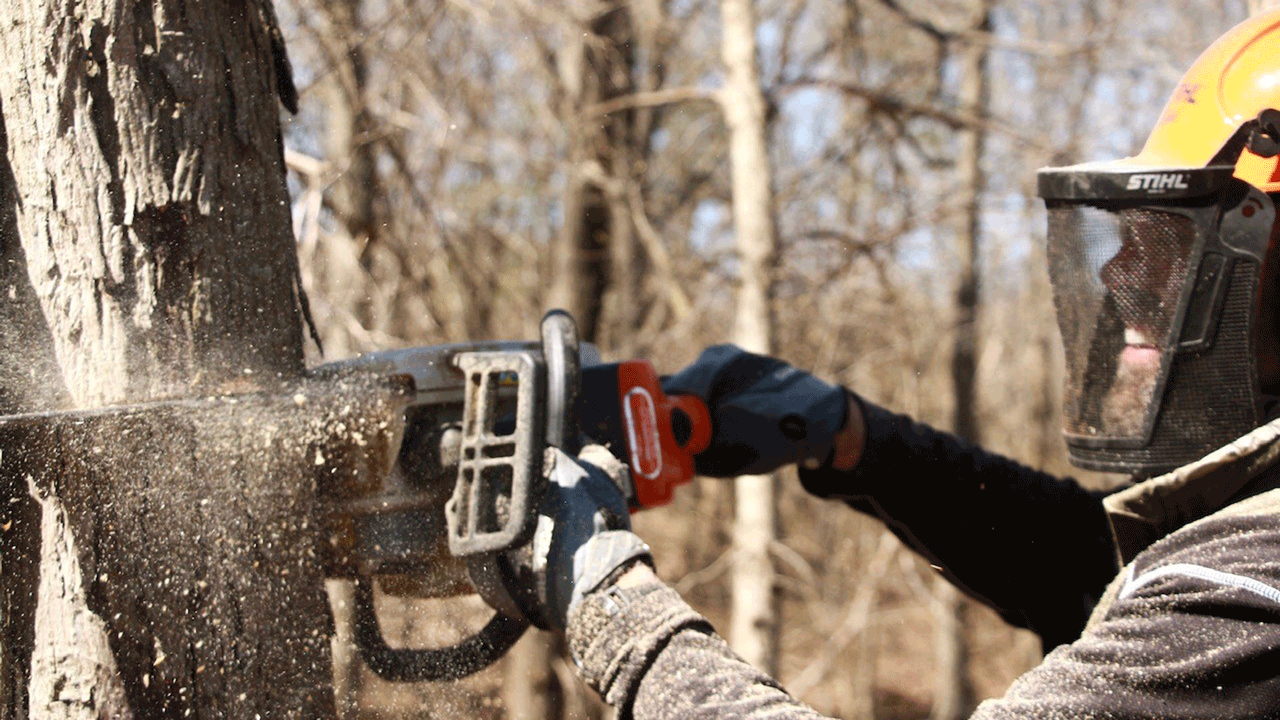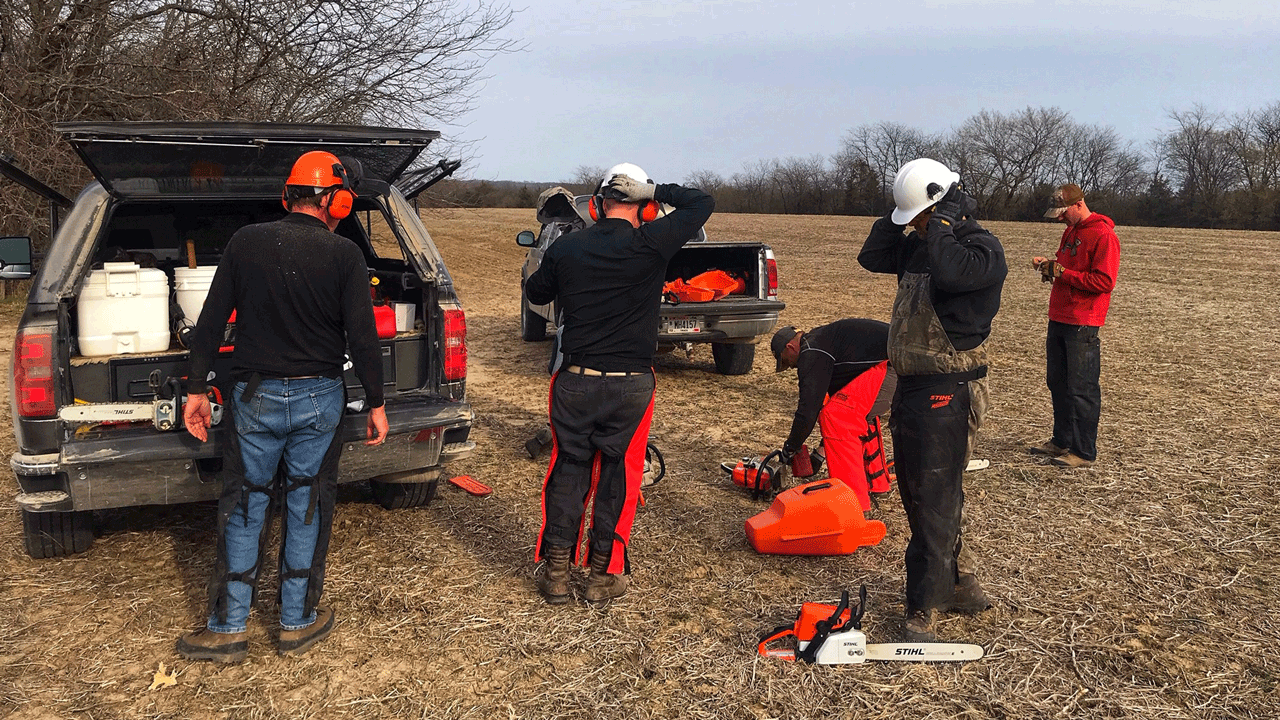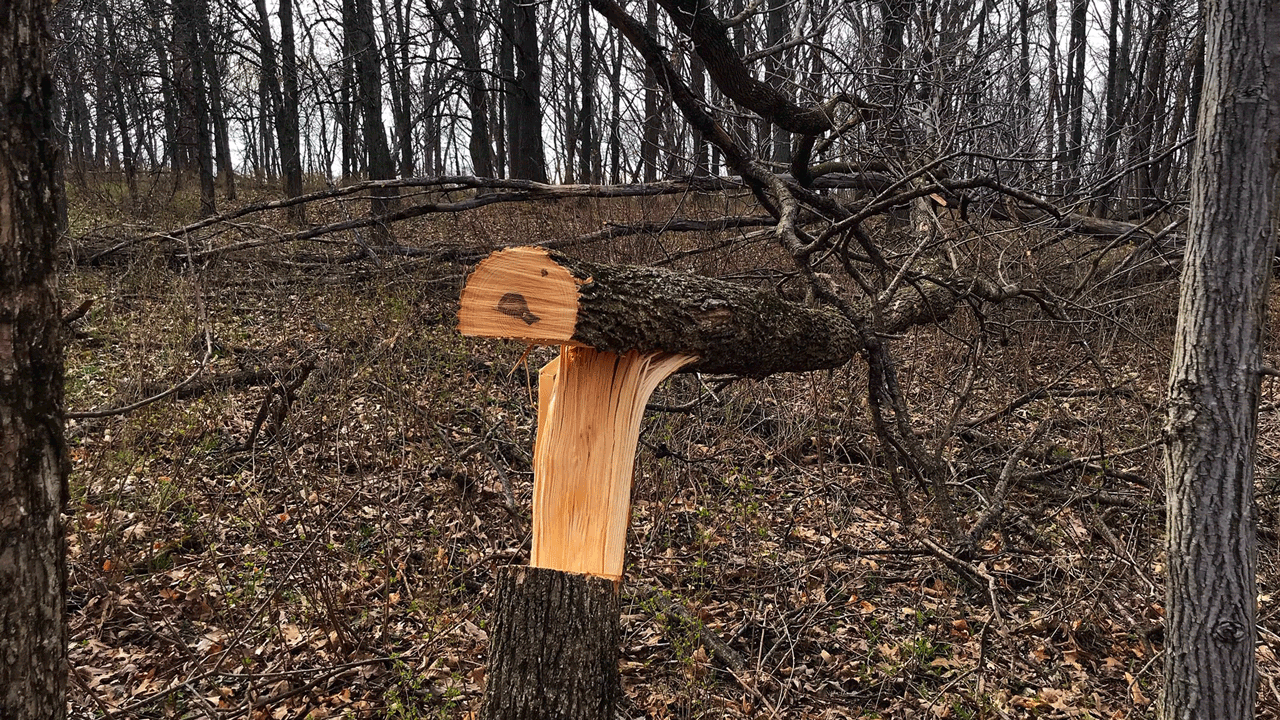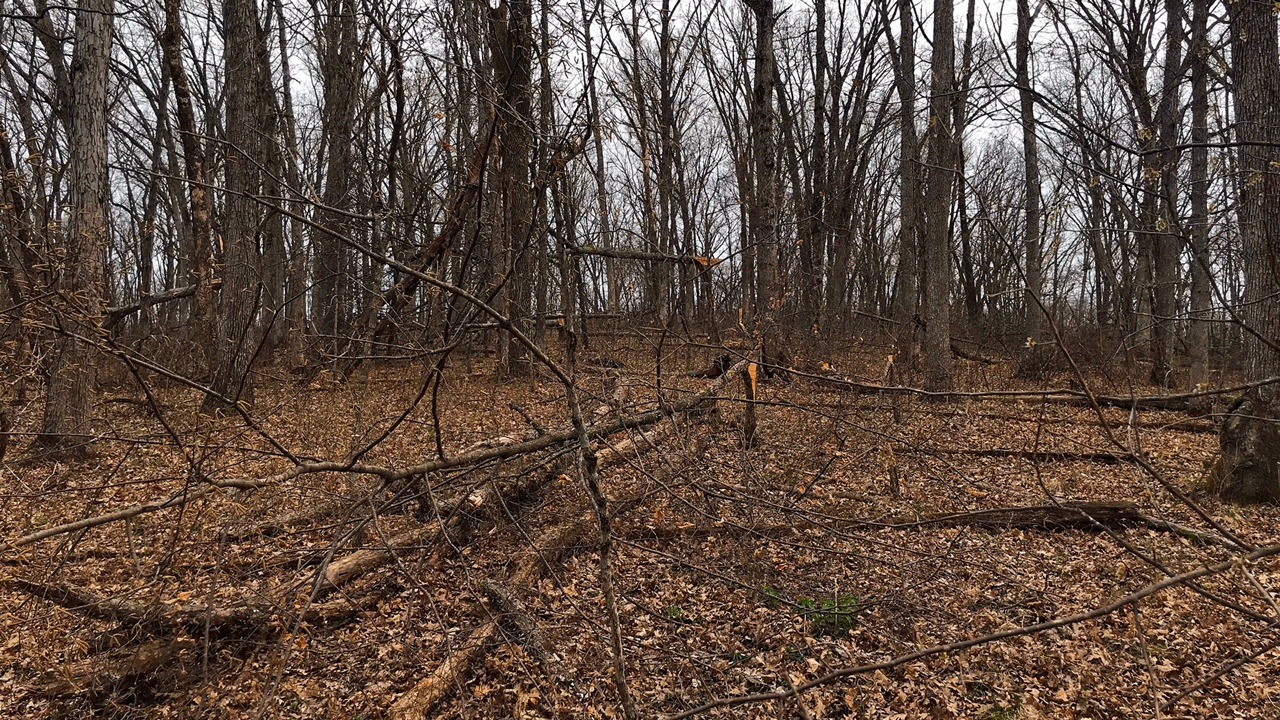“Timber Stand Improvement (TSI) is the reduction or elimination of non-desirable flora species competing directly with the ones that should be encouraged. Eliminating competitive, low-value species results in positive influences across the entire ecosystem. Hinge cutting is one of the most beneficial methods of TSI. This is cutting partially through a live, actively growing (competitive) tree and pushing or pulling it over to lay the trunk down horizontal to the ground.” – Tom James, Whitetail Properties.

To properly hinge cut, a horizontal cut is made in the tree approximately four to six feet high.
I recently spent a weekend helping some friends and fellow bowhunting enthusiasts hinge cut portions of their property. It was my first experience in such habitat improvement, but the crew I was with were much more versed in the process. After a full day of chain saws sounding off in all directions, I now have experience in the art of hinge cutting. Before you get too excited and start cutting down all your trees, here are five things to keep in mind when working on your own TSI on your property.
Wear the proper PPE (Personal Protective Equipment)
Since our focus area was large tracts of timber, everyone on our crew was equipped with a chain saw. You can hinge cut trees with a hand saw or even a machete, but when dealing with any decent size tree, a chain saw is a much better choice. Gloves are a must when working in the timber with a saw in hand. Safety glasses help keep saw dust and other debris out of your eyes. Hinge cutting involves making horizontal cuts between four and six feet off the ground. This coupled with a little breeze and you have saw dust floating around your face all day. A good pair of tight-fitting safety glasses helps keep that dust out of your eyes. A helmet equipped with ear muffs and a face shield is also a must. I was skeptical about this piece when we first started cutting. Then about mid-day, I had a small tree that was hung-up on a larger tree that I was intending to cut also. When I cut the larger tree and pushed it down, the smaller tree that was hung-up on it, slid off to the side and caught me square on the head. Since I was wearing my helmet, it simply bounced off and no harm was done. Had I not had the helmet on, at a minimum, I would’ve had a nice bump and bruise on the top of my head. The final, and possibly the most important piece of PPE to have on, is a good pair of chaps. When using a chain saw at chest high all day, you tend to get a bit complacent when bringing the saw back down to waist level. This is when it’s very easy to catch your pant leg as the chain is still in motion. With chaps designed for chain saw use, the chain will grab the material inside the chaps and bind up the chain to force it to stop. This process not only saves your pants from being torn up, but also saves your leg from a nasty cut. If you are using a chain saw to complete your hinge cutting, you will want to be dawning these pieces of PPE.

“Prior to starting any work in the timber, make sure you and your crew have the proper personal protective equipment.”
Know Your Tree Species
The main purpose of hinge cutting is to create better habitat for wildlife, especially whitetails. By cutting and eliminating competing trees, you are also benefiting the growth of the more desirable trees. Before you go clear cutting your timber, you are going to want to become familiar with the tree species in your area. There are many ways to accomplish such a task, but one of the best ways is to contact your local Forester and have them visit your property and point out the trees you want to avoid cutting. All mast producing trees and trees that will hold value in the future (American Black Walnut for example) you will want to leave alone. Hinge cutting is a great way to create travel routes, bedding areas, and staging areas. There are times when cutting an oak or maple is necessary to complete the desired outcome. When this happens, try to cut the trees that will allow some of the surrounding trees to benefit. By knowing your tree species, you can assure you are improving habitat verses doing more harm by removing desirable trees from your timber.

This is an example showing a properly cut tree. When the timber greens up, this area will provide browse and cover for wildlife.
Spread Out
If your time is limited and you want to accomplish as much cutting as possible, you are going to want to enlist the help of friends or family. Instruct everyone involved on the process of hinge cutting and what the desired result is. Make sure everyone has their proper PPE on and spread out! It’s dangerous enough cutting trees down, but it can be even more dangerous when there are multiple people cutting trees down all around you. Take the time to establish a plan and direct your help to different areas that have plenty of space between individuals. It’s helpful if your PPE is bright colored so you can locate one another quickly and easily when moving throughout your hinge cutting area. Keep your distance from all others and always check the direction you anticipate the tree to fall before you make your cut.
Admire Your Work
Once you have completed an area of cutting, step back and admire what you have accomplished. Review the area from multiple perspectives (field edges, trail crossings, etc.) to be certain all your hard work paid off. Check to see that you have created trails or lanes where you wanted. Imagine walking to your stand to determine if deer could bed and feel safe in the hinge cut areas you just created. Verify you added browse to an area that might possibly hold deer a bit longer. See how your area looks from a TSI perspective. Did you reduce less desirable trees so the mast producing and income producing trees have minimal competition and can flourish? Also try to get down to a deer’s eye level and view the area from their perspective. If possible, cut some strait logs approximately four to five feet in length. Place those straight logs on the ground amongst the tree tops you just cut and left horizontal. Clear some of the brush and debris on the ground in front of the logs. Whitetails like to put their backs against something when bedding so they feel protected and can watch the open areas as they lay in their beds. By placing the logs against the tree tops and clearing the area in front of the logs, you have just created natural beds for the deer.

The author recently spent a weekend hinge cutting to improve habitat. This is an area after the cutting is complete.
Have Fun
Finally, have some fun! Habitat management and improvement involves a lot of hard work. Assemble a good crew to help and enjoy the day. Take plenty of breaks to stay hydrated and relish the company of your fellow hunting enthusiasts. On my recent weekend of hinge cutting, I went into the day not knowing everyone involved. By the end of the day, we were all sitting on tailgates sharing stories of our hinge cutting learning experiences and toasting our accomplishments with some ice-cold beverages. It was truly a weekend I will never forget. Don’t be afraid to head to the timber with chain saw in hand and create better habitat for your local deer herd. It’s remarkable how much you can accomplish in a short amount of time. Be safe and have a blast!

 By
By 



